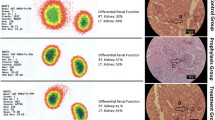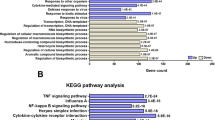Summary
Renal scars are thought to be the end stage of chronic pyelonephritis and one of the most important causes of renal insufficiency and renal hypertension. The role of bacterial pili was examined in scar formation after an infection of newly constructed bacterial strains using the recombinant DNA technique, which possessed either mannose resistant (MR) or mannose sensitive (MS) pili of Serratia marcescens. Strains that differed in only a single virulence factor, namely, MR or MS pili, were used in a rat model of chronic pyelonephritis. In this model, MS-piliated bacteria stimulated renal scarring more severely than non-piliated or MR-piliated bacteria.
Similar content being viewed by others
References
Amako K, Ohshima H, Yasunaka K (1981) Pili mediated agglutination of Serratia marcescens in human urine. Microbiol Immunol 25:981
Dominique GJ, Roberts JA, Laucirica R (1985) Pathogenic significance of P-fimbriated Eschericia coli in urinary tract infections. J Urol 133:983
Evans DG (1979) Purification and characterization of the CFA/I antigen of enterotosigenic Escherichia coli. Infect Immunol 25:738
Glauser MP, Lyons JM, Braude AI (1978) Prevention of chronic experimental pyelonephritis by suppression of acute suppuration. J Clin Invest 61:403
Harber MJ, (1986) Virulence factors of urnary pathogens in relation to kidney scarring. In: Asscher AW, Brumfitt W (eds) Microbial disease in Nephrology. Wiley, Chichester, p 69
Jingushi S, Mitsuyama M, Morya T, AMako K (1987) Antigenic analysis of Serratia marcescens fimbriae with monoclonal antibodies. Infect Immun 55:1600
Kohno K, Yamamoto T, Kuroiwa A, Amako K (1984) Purification and characterization of Serratia marcescens US5 pili. Infect Immun 46:295
Latham RH, Stamm WE (1984) Role of fimbriated Escherichia coli in urinary tract infections in adult women: correlation with localization studies. J Infect Dis 149:835
Matsumoto T, Tanaka M, Kumazawa J (1987) Hemagglutination by various species of bacteria isolated from the urine of patients with urinary tract infections. Nishinihon J Urol 49:95
Mizunoe Y, (1988) Cloning and sequence of the gene encoding the major structural component of mannose-resistant fimbriae of Serratia marcescens. J Bacteriol 170:3567
Reid G, Sobel JD (1987) Bacterial adherence in the pathogenesis of urinary tract infection: a review. Rev Infect Dis 9:470
Slotki IN, Asscher AW (1982) Prevention of scarring in experimental pyelonephritis in the rat by early antibiotic therapy. Nephron 30:262
Yamamoto T, Ariyoshi A, Amako K (1985) Fimbria-mediated adherence of Serratia marcescens strain US5 to human urinary bladder surface. Microbiol Immunol 29:677
Author information
Authors and Affiliations
Rights and permissions
About this article
Cite this article
Matsumoto, T., Mizunoe, Y., Sakamoto, N. et al. Increased renal scarring by bacteria with mannose-sensitive pili. Urol. Res. 18, 299–303 (1990). https://doi.org/10.1007/BF00300774
Accepted:
Issue Date:
DOI: https://doi.org/10.1007/BF00300774




